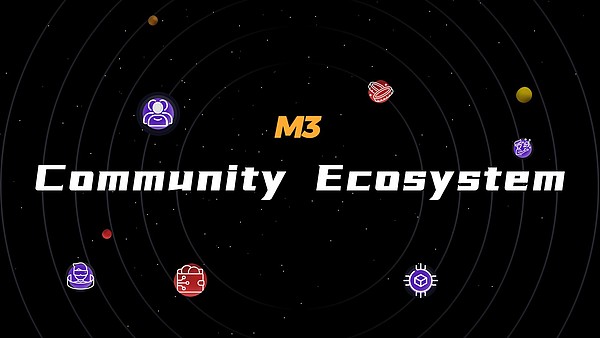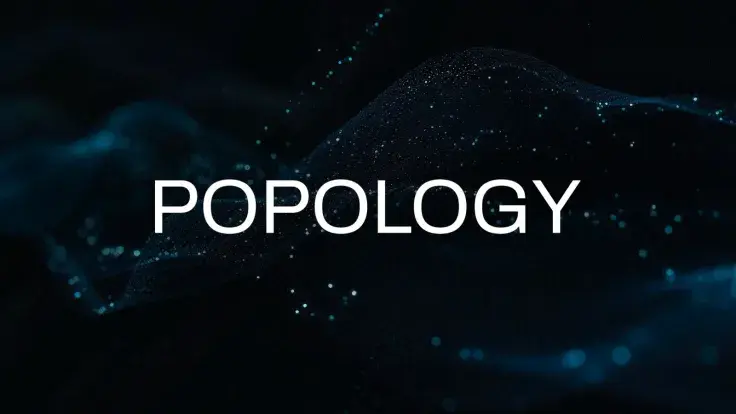With the rapid rise of Web3, the construction of decentralized communities has become one of the core elements of the digital world. However, looking at the current Web3 communities, despite the deep-rooted concept of decentralization, practical operations face numerous challenges. Low user engagement, insufficient governance efficiency, and weak economic incentive mechanisms have caused many Web3 communities to stagnate in their early stages. M3 DAO has recognized this pain point and, through a comprehensive chain layout from points to planes, started from small-scale seed communities and gradually evolved into a global, multi-track collaborative ecosystem, providing new ideas for community governance and sustainable development in Web3.

The Dilemma of Web3 and M3 DAO’s Solution
Decentralized communities in Web3 offer users autonomy and freedom, but they also present complex governance and development challenges to the communities themselves. Even the DeFi star Uniswap has faced issues of voting power concentration among "whale users" and low user engagement in its community-driven governance. The openness of blockchain attracts numerous users, but relying solely on decentralized governance mechanisms often fails to ensure the long-term vitality of the community. M3 DAO has noticed this and has begun to focus on product and user experience, starting to build the "origin point" of the community ecosystem and gradually exploring a growth path from points to planes, providing unique solutions to the governance challenges of Web3 communities.
Through in-depth research and observation, M3 DAO realized that to make decentralized communities attractive in their early stages, innovation in governance and user experience is essential, rather than simply replicating existing models. For example, while decentralized alternatives to traditional social media eliminate platform monopolies, they often cannot compete with mature products in terms of functionality and experience, limiting user engagement and stickiness. M3 DAO's innovations in product layout and user experience are based on this understanding, laying a solid foundation for the steady development of the community in its early stages.
Focusing on Products to Gather M3 DAO's Early Strength
User loyalty to a community largely stems from the value provided by the product. Therefore, in the early stages of development, M3 DAO focused on refining products and optimizing experiences, committed to offering high-quality on-chain financial services, content, and games to meet users’ diverse needs. Through precise market positioning and user analysis, M3 identified the core functions of its product matrix, allowing users to gain tangible economic returns and entertainment experiences through on-chain interactions. This user experience laid the groundwork for high loyalty among early users and enabled M3 DAO to attract a group of loyal "origin point" users in its early stages.
This strategy is reminiscent of Netflix’s early membership marketing model. Netflix quickly attracted a loyal audience through price discounts and rich content accumulation, forming brand recognition. The initial users of M3 DAO played a similar role: they were not only participants in the community but also promoters of community culture. They played an important role in M3 DAO's community interactions and governance mechanisms, gradually forming the "starting point" of the community and laying a strong user foundation for subsequent expansion.
During this stage, M3 DAO also encouraged users to participate in interactions and governance through the platform's reward mechanisms, significantly enhancing early user engagement. With positive feedback from these users, M3 DAO continuously optimized product experiences, increasing users' sense of belonging and participation on the platform, and gradually forming a core user base. This stable and deep user foundation gives M3 DAO the confidence and support to expand into the entire chain ecosystem.
Comprehensive Ecosystem Layout Drives User Growth and Community Expansion
After establishing a loyal user base, M3 DAO realized that the next step in community growth lies in expanding collaborative synergies with external resources. To this end, M3 DAO has adopted an active cooperation strategy, uniting multiple high-quality projects and integrating leading resources from various fields to enhance the community's brand influence comprehensively. This strategy not only increased user awareness of M3 DAO but also brought in user resources from quality projects across different domains, promoting steady community growth.
In various sectors such as DeFi, GameFi, and MediaFi, M3 DAO has formed deep collaborations with leading projects like Rocket, U-topia, DeepLink, and VooPay, leveraging each other's resources and user bases to create a mutually beneficial network effect. For example, through collaboration with Rocket, M3 DAO can inject DeFi liquidity into tokens and NFTs of GameFi projects, providing greater appreciation opportunities. Users can also utilize digital assets obtained on U-topia’s MediaFi content platform for on-chain payments and transactions through VooPay, further enhancing asset liquidity. This multi-sector synergy not only meets users' diverse needs but also deepens M3 DAO's brand effect through interactions with these quality projects, attracting more user attention and deeper participation.
This brand synergy effect is akin to the "flywheel effect" established by Amazon in its early days—creating a self-reinforcing ecosystem through the integration of different services. The ecological network built by M3 DAO in collaboration with quality projects continuously attracts new users and provides value-added experiences across various application scenarios. This collaborative approach positions M3 DAO not just as a single service platform but as a comprehensive ecosystem for resource integration and cross-industry interaction, effectively driving user growth and solidifying user retention, thereby laying a solid foundation for future expansion.
During this stage, M3 DAO also introduced a DAO governance mechanism, gradually decentralizing governance power to the community, allowing users to be not just consumers of services but also participants in ecological governance. Users gain voting rights and participation in various activities on the platform, truly realizing multi-faceted participation in a decentralized community. This ecological expansion allows M3 DAO to gradually transform from "points" to "planes," attracting more new users while effectively stabilizing the existing user base, and gradually forming a scale effect in the comprehensive community.
Localized Operation Strategy with a Global Perspective
In its global expansion, M3 DAO adopts a localized operation strategy, tailoring services and content to meet the demands of different markets. With early supporting points in Dubai, Singapore, Hong Kong, London, Berlin, and Paris, M3 DAO conducts in-depth research on user needs and preferences in these regions, formulating personalized operational plans. In different areas, M3 DAO customizes product strategies based on local user needs and behaviors, attracting users to engage deeply in the ecosystem.
This global-local strategy is reminiscent of TikTok's global expansion approach. TikTok did not employ a fixed operational strategy when entering various countries; instead, it localized according to each market's culture and user habits, achieving explosive growth. Similarly, M3 DAO employs a localized strategy globally, aiming to establish a regional operational model that provides services closely aligned with user needs. Through this regional focus, M3 DAO has built a decentralized community network with hundreds of thousands of active users across over 60 countries and regions.
M3 DAO's global approach not only maintains its competitiveness in different markets but also allows users to participate in community governance and operations with a stronger sense of belonging. This combination of globalization and localization enables users in various regions to engage deeply in community building, gradually achieving a synergistic effect in the global community.
Ecological Closed-Loop Effect from a Diverse Product Matrix
M3 DAO has gradually constructed a "product-community-ecosystem" closed loop through a diversified product matrix, continuously promoting community growth and ecological development. In areas such as on-chain finance, content creation, blockchain gaming, and payment services, M3 DAO has launched a series of products that meet users' multi-layered needs, integrating the advantages and characteristics of various sectors into a comprehensive decentralized platform. This not only allows users to enjoy a rich application experience within the ecosystem but also forms a stable income cycle through cross-sector asset circulation and revenue sharing.
In the integration of blockchain gaming and DeFi, M3 DAO collaborates with the Rocket platform, enabling tokens and NFTs earned within the GameFi ecosystem to be directly staked or lent in Rocket's liquidity pool. This process allows users to quickly convert virtual assets from games into financial returns, further enhancing the value and liquidity of these assets. Moreover, gaming users can also use their assets for staking and trading in DeFi applications, enjoying opportunities for reinvestment of earnings. Through this multi-scenario asset utilization and liquidity support, M3 DAO not only meets user needs but also promotes asset activity within the community.
Additionally, VooPay serves as the engine for the payment platform, significantly simplifying cross-sector transaction experiences and becoming M3 DAO's payment hub. Through VooPay, users can seamlessly transfer earnings obtained in any on-chain scenario into other applications within the ecosystem, achieving an "earn-and-use" closed-loop payment model, allowing users to easily exchange cryptocurrency assets. This one-stop payment system not only enhances user experience but also facilitates asset circulation within the ecosystem.
M3 DAO's diversified product matrix fosters a virtuous flywheel interaction among various sectors, akin to Apple's closed-loop ecosystem—from hardware to the App Store and then to content consumption, every transaction enhances Apple's ecosystem stickiness. Users can earn rewards across different applications, and these rewards can further drive community growth. This revenue-driven ecological closed loop not only enhances long-term user loyalty but also lays a solid foundation for the community's self-expansion and ecological vitality.
Insights from M3 DAO on Web3 Community Governance
M3 DAO's decentralized governance model not only serves as a driver for community expansion but also exemplifies how Web3 communities can break through traditional governance frameworks to achieve user-driven ecological growth. M3 DAO's governance design demonstrates that community governance can achieve deep user participation and ecological sustainability through refined incentives, multi-layered autonomy, and global-local strategies, providing several key directions for Web3.
Firstly, M3 DAO cleverly combines users' economic interests and social interactions through multi-layered incentives, breaking the common short-term participation phenomenon in Web3 communities. Incentives here are not just direct returns in digital assets but form a dynamic ecosystem—users participate and add value across different ecological modules, such as the conversion between gaming assets and financial returns, thereby creating cross-scenario benefit circulation. This design indicates that Web3's incentive mechanisms require more complex collaborative effects, where users are no longer confined to a single application scenario but can flexibly realize value appreciation across various modules. M3 DAO's incentive structure suggests to Web3 communities that incentives should be designed around users' "experience journeys," providing incremental benefits from entry to deep participation to stimulate users' long-term recognition and initiative towards the community.
Secondly, M3 DAO addresses the governance "homogenization" issue in community expansion through a global-local autonomous strategy in its governance structure. Most Web3 projects adopt a unified governance framework when expanding globally, overlooking cultural and market differences, while M3 DAO appropriately decentralizes power and rules, granting regional supporting points autonomy. This structure resembles a "multi-center" governance system, where each region's governance mechanism serves local users while coordinating with the overall framework. M3 DAO's localized governance reveals a new possibility: Web3 communities do not have to adopt a single governance model but can promote deep decentralized development based on multi-center autonomy according to regional needs. This suggests that global governance in Web3 should not only be about decentralization but also about "de-homogenization" by adapting diverse governance structures to different markets.
Furthermore, M3 DAO's governance model achieves a natural integration of product experience and governance power through tight ecological interactions and resource sharing. M3 DAO's DAO governance not only empowers users with decision-making rights but also allows users to truly "benefit from participation" through the realization of product closed-loop value. In traditional Web3 projects, governance and product use often run parallel, making it difficult to establish a direct link between users' enthusiasm for participating in governance and their product usage experience. M3 DAO's governance design breaks this limitation by ensuring that every user decision and interaction brings actual economic value, making governance power not just an abstract voting mechanism but a part of users' daily experience. This suggests that Web3 communities can integrate governance mechanisms into product design, allowing users to experience the interplay between governance and benefits, making them true members of the ecosystem rather than mere consumers.
M3 DAO's decentralized governance model showcases a resilient and adaptive ecological paradigm for the future of Web3. The key to Web3 community governance is no longer just technical decentralization but how to maintain long-term growth in a constantly changing market based on user-driven, regional autonomy, and ecological closed loops. This multi-dimensional collaborative governance opens up broader innovation spaces for Web3, indicating that future community governance needs to find a balance between technology and experience and achieve multi-center autonomy based on global needs, thereby building a more inclusive and sustainable decentralized community.
Keywords: #M3DAO #decentralization #BNB #WEB3



